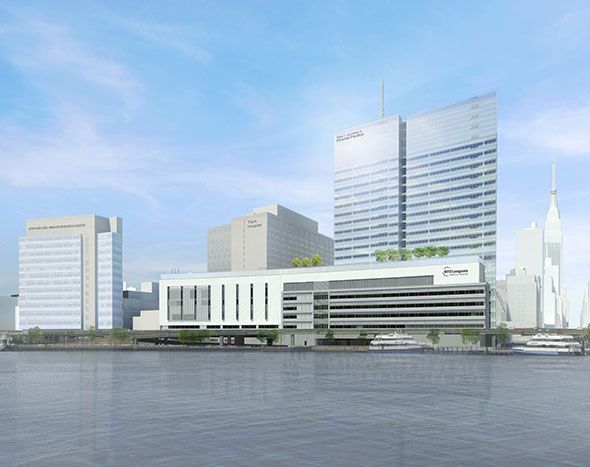facilities
The Phoenix on First
not even a historic storm could shutter nyu langone medical center for long
by Nicole Pezold / GSAS ’04
On the October night that Hurricane Sandy rushed into New York City, Paul Schwabacher, the senior vice president of facilities management for NYU Langone Medical Center, was hunkered down with his team in a makeshift command center on First Avenue and 30th Street. In the preceding days, the facilities team had prepared for the storm much like they did for Hurricane Irene, bringing in water pumps and additional fuel oil, and sealing up low-lying areas with plywood, plastic, and sandbags. As a 14-foot surge pushed its way up the East River, Schwabacher was monitoring the campus’s perimeter and basements via security cameras.
“First thing that happened, I saw the video go out,” he remembers. Some of the lights and power systems began to shut off. Schwabacher ran down to the basement. Water was pouring in—eventually 15 million gallons would fill the buildings just on the superblock that runs along First Avenue in the low 30s. “It felt like a movie set,” he says.
All the world (or at least those with power) watched what happened next: An orderly, if surreal, evacuation of patients to 14 area hospitals on higher ground, including the delicate transfer of 20 infants from the Neonatal Intensive Care Unit by a team of heroic nurses. More than 300 patients were safely evacuated over the course of 13 hours.
In the light of the next days, NYU Langone surveyed the destruction. Its mechanical, plumbing, and electrical systems had suffered extensive damage; some state-of-the-art equipment—such as MRIs, a gamma knife used for brain surgery, and a linear accelerator used for the treatment of cancer—was also destroyed. But more than just equipment was lost. Thousands of laboratory mice perished; refrigerated tissue samples and other temperature-sensitive materials spoiled. Class and research spaces were damaged. A premier academic medical center was bowed before Mother Nature. It was, perhaps, its lowest point in nearly two centuries, which makes its breakneck rebound all the more astounding.
Immediately, the medical center got to work, with the aid of $150 million from FEMA and around-the-clock crews, who for a time only stopped for meals and sleep. A week after the storm, the outpatient facilities were back in business. Another two weeks later, they opened one of the main buildings, Skirball Institute, and a month after that, Tisch Hospital itself. By mid-January, a mere two-and-a-half months after the storm, the campus was essentially fully operational. “That was the goal,” Schwabacher says, “to reopen the doors, reopen for business again as fast as possible.”
When Sandy hit, NYU Langone’s complex was already in the midst of a major capital development program to construct new energy, hospital, and science buildings, as well as an overhaul of the Emergency Department. (The ED remains closed until the renovation is complete in early 2014; in the meantime, the medical center has opened an urgent-care center to serve the public.) The buildings, which include a new co-generation power plant, were already designed with an eye toward rising sea levels and the more virulent storms predicted with climate change by locating all critical systems above the 500-year flood level. Here was an opportunity to go even further. The goal now is to protect the campus to two feet beyond that—and critical infrastructure to at least six feet higher—to a level seven to 11 feet higher than Sandy. Buildings surrounding the main campus will also be outfitted with barriers that can flip into place and act as bulwarks.
There’s good news for Sandy’s tiniest survivors, too. Some 54 cages of mice were rescued and have been outfitted with a new aboveground colony, which is only a recent innovation for these types of facilities. “Traditional wisdom dictates that you put colonies in the basement,” explains neuroscientist, physiologist, and cell biologist Gordon Fishell, because of the heavy machinery and copious flow of water required to keep the space pathogen free, among other factors. So the mice, which are genetically altered to help doctors better understand everything from cancer to heart disease, are making their own rebound, alongside the students, post-docs, and colleagues who study them.
Fishell’s lab focuses on seizures, and he says their work never truly slowed, and predicts the same for the university. “If you look at NYU Langone’s output and performance in five years, by any measures, you’d be hard-pressed to know this hit us,” Fishell explains. “And that really speaks to the strength of the comeback, the dedication of everyone here.”







